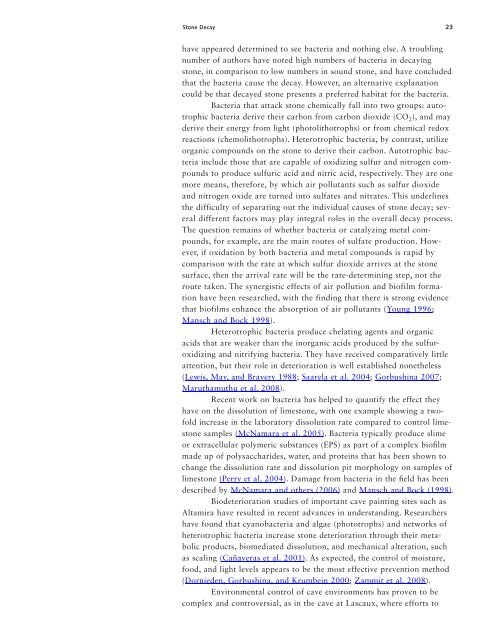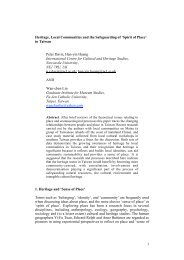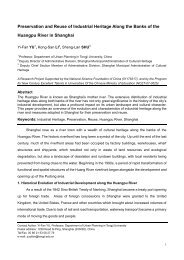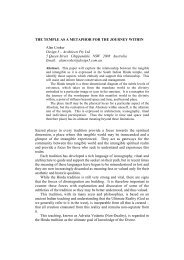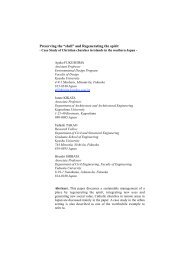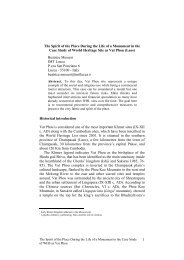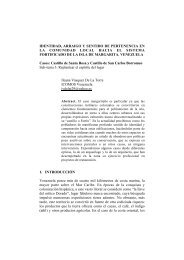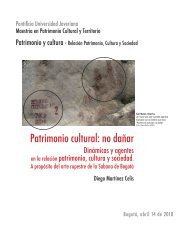<strong>Stone</strong> Decay 23have appeared determined to see bacteria and nothing else. A troublingnumber <strong>of</strong> authors have noted high numbers <strong>of</strong> bacteria in decayingstone, in comparison to low numbers in sound stone, and have concludedthat the bacteria cause the decay. However, an alternative explanationcould be that decayed stone presents a preferred habitat for the bacteria.Bacteria that attack stone chemically fall into two groups: autotrophicbacteria derive their carbon from carbon dioxide (CO 2 ), and mayderive their energy from light (photolithotrophs) or from chemical redoxreactions (chemolithotrophs). Heterotrophic bacteria, by contrast, utilizeorganic compounds on the stone to derive their carbon. Autotrophic bacteriainclude those that are capable <strong>of</strong> oxidizing sulfur and nitrogen compoundsto produce sulfuric acid and nitric acid, respectively. They are onemore means, therefore, by which air pollutants such as sulfur dioxideand nitrogen oxide are turned into sulfates and nitrates. This underlinesthe difficulty <strong>of</strong> separating out the individual causes <strong>of</strong> stone decay; severaldifferent factors may play integral roles in the overall decay process.The question remains <strong>of</strong> whether bacteria or catalyzing metal compounds,for example, are the main routes <strong>of</strong> sulfate production. However,if oxidation by both bacteria and metal compounds is rapid bycomparison with the rate at which sulfur dioxide arrives at the stonesurface, then the arrival rate will be the rate-determining step, not theroute taken. The synergistic effects <strong>of</strong> air pollution and bi<strong>of</strong>ilm formationhave been researched, with the finding that there is strong evidencethat bi<strong>of</strong>ilms enhance the absorption <strong>of</strong> air pollutants (Young 1996;Mansch and Bock 1998).Heterotrophic bacteria produce chelating agents and organicacids that are weaker than the inorganic acids produced by the sulfuroxidizingand nitrifying bacteria. They have received comparatively littleattention, but their role in deterioration is well established nonetheless(Lewis, May, and Bravery 1988; Saarela et al. 2004; Gorbushina 2007;Maruthamuthu et al. 2008).Recent work on bacteria has helped to quantify the effect theyhave on the dissolution <strong>of</strong> limestone, with one example showing a tw<strong>of</strong>oldincrease in the laboratory dissolution rate compared to control limestonesamples (McNamara et al. 2005). Bacteria typically produce slimeor extracellular polymeric substances (EPS) as part <strong>of</strong> a complex bi<strong>of</strong>ilmmade up <strong>of</strong> polysaccharides, water, and proteins that has been shown tochange the dissolution rate and dissolution pit morphology on samples <strong>of</strong>limestone (Perry et al. 2004). Damage from bacteria in the field has beendescribed by McNamara and others (2006) and Mansch and Bock (1998).Biodeterioration studies <strong>of</strong> important cave painting sites such asAltamira have resulted in recent advances in understanding. <strong>Research</strong>ershave found that cyanobacteria and algae (phototrophs) and networks <strong>of</strong>heterotrophic bacteria increase stone deterioration through their metabolicproducts, biomediated dissolution, and mechanical alteration, suchas scaling (Cañaveras et al. 2001). As expected, the control <strong>of</strong> moisture,food, and light levels appears to be the most effective prevention method(Dornieden, Gorbushina, and Krumbein 2000; Zammit et al. 2008).Environmental control <strong>of</strong> cave environments has proven to becomplex and controversial, as in the cave at Lascaux, where efforts to
24 Chapter 1limit the introduction <strong>of</strong> fungal strains through the use <strong>of</strong> a formalde -hyde foot-wash treatment for visitors resulted in the growth <strong>of</strong> aformaldehyde-resistant strain <strong>of</strong> white Fusarium solani fungus (Bastianet al. 2007; Dupont et al. 2007; Jurado et al. 2009; Bastian andAlabouvette 2009; Bastian et al. 2009; Bastian, Alabouvette, and Saiz-Jimenez 2009). This condition may have been exacerbated by the installation<strong>of</strong> a new ventilation system (Brunet, Malaurent, and Lastennet 2006;Lacanette et al. 2009). Computer modeling <strong>of</strong> the airflow at the Lascauxcave suggests that reducing the airflow may help avoid future damage(Malaurent et al. 2007).The role <strong>of</strong> halophilic microbes (mostly archaea, with some bacteria)is important in stone decay (Laiz et al. 2000; Saiz-Jimenez and Laiz2000). A significant and open question is if hydroscopic salts may raisemoisture levels to the point where halophilic microbes increase in abundance,setting the stage for further microbial development <strong>of</strong> adjacentareas <strong>of</strong> stone.Differential StressWhile air pollution, salts, and biodeterioration capture the lion’s share<strong>of</strong> attention, there are advances in our understanding <strong>of</strong> other, <strong>of</strong>tenrelated decay mechanisms that are worth some consideration. Reviewingthe recent literature on stone conservation, it is clear that there is animportant trend in decay mechanism research that is focusing on whatis called here (for want <strong>of</strong> a better term) “differential stress.” This decaymechanism includes the effects <strong>of</strong> wet/dry cycling, clay swelling, differentialhygric stress, differential thermal stress, and stress from differentialexpan sion rates <strong>of</strong> material in pores (such as salts or organic material)versus in the stone. The general idea is that treatments, salts, water films,or bi<strong>of</strong>ilms—anything that causes the stone surface to react differentlythan the interior—can result in a shear stress, crack propagation, and,eventually, surface parallel detachment (e.g., flaking). For example, significantshear stress is generated when, during a brief afternoon rain, thesurface <strong>of</strong> a clay-containing stone swells, while the interior <strong>of</strong> the stoneremains dry (Doehne et al. 2005). This would be considered an example<strong>of</strong> differential hygric stress and is typically found on the corners <strong>of</strong> stonessuch as Sydney sandstone and Portland brownstone. As mentioned earlier,sodium chloride expands at approximately five times the rate <strong>of</strong> calcite atsurface temperatures, so decay in limestone from this mechanism wouldbe an example <strong>of</strong> stress induced by differential thermal expansion (Nocita1987; Holmer 1998; Smith et al. 2005). Note that salts naturally tend toaccumulate near the stone surface, setting up differences in how the twoparts <strong>of</strong> the stone (surface and interior) react to environmental changes.Modeling has shown that there may be a particular depth beneath thestone surface where moisture is present and salts may accumulate(Snethlage and Wendler 1997). This depth is <strong>of</strong>ten the same as the thickness<strong>of</strong> stone flakes or scales. Differential thermal expansion stresses mayalso be induced at the interface between minerals having different colors,for instance in granites exposed to direct sunlight (Casta 1988). Fieldmeasurements <strong>of</strong> stone surfaces show that rapid thermal variations aremore common than previously thought (Molaro and McKay <strong>2010</strong>).
- Page 2 and 3: esearch in conservationThe Getty Co
- Page 4 and 5: Contentsvi Foreword to the Second E
- Page 6 and 7: ContentsvChapter 7 75 What Has Chan
- Page 8 and 9: Foreword to the Second Edition, 201
- Page 10: Preface to the Second Edition, 2010
- Page 13 and 14: Chapter Preface to # the First Edit
- Page 15 and 16: IntroductionAfter presenting his wo
- Page 18 and 19: Stone Decay 3ize terminology (Stone
- Page 20 and 21: Stone Decay 5.hpl.hp.com/news/2004/
- Page 22 and 23: Stone Decay 7ing the difficult chal
- Page 24 and 25: Stone Decay 9has shown that if both
- Page 26 and 27: Stone Decay 11Damage to stone by ai
- Page 28 and 29: Stone Decay 13Some intriguing findi
- Page 30 and 31: Stone Decay 15crossing the deliques
- Page 32 and 33: Stone Decay 17pick up moisture from
- Page 34 and 35: Stone Decay 19by differences in the
- Page 36 and 37: Stone Decay 21Biological growths on
- Page 40 and 41: Stone Decay 25Organic material in p
- Page 42 and 43: Chapter 2Putting It Right: Preventi
- Page 44 and 45: Stone Putting Decay It Right: Preve
- Page 46 and 47: Stone Putting Decay It Right: Preve
- Page 48 and 49: Stone Putting Decay It Right: Preve
- Page 50 and 51: Stone Putting Decay It Right: Preve
- Page 52 and 53: Stone Putting Decay It Right: Preve
- Page 54 and 55: Stone Putting Decay It Right: Preve
- Page 56 and 57: Stone Putting Decay It Right: Preve
- Page 58 and 59: Stone Putting Decay It Right: Preve
- Page 60 and 61: Stone Putting Decay It Right: Preve
- Page 62 and 63: Stone Putting Decay It Right: Preve
- Page 64 and 65: Chapter 3Do They Work? Assessing th
- Page 66 and 67: Stone Do They Decay Work? Assessing
- Page 68 and 69: Stone Do They Decay Work? Assessing
- Page 70 and 71: Stone Putting Decay It into Practic
- Page 72 and 73: Stone Putting Decay It into Practic
- Page 74 and 75: Stone Heritage Decay in Stone: Rock
- Page 76 and 77: Stone Heritage Decay in Stone: Rock
- Page 78 and 79: Stone Heritage Decay in Stone: Rock
- Page 80 and 81: Stone Heritage Decay in Stone: Rock
- Page 82 and 83: Stone Doing Decay Better: Increasin
- Page 84 and 85: Stone Doing Decay Better: Increasin
- Page 86 and 87: Stone Doing Decay Better: Increasin
- Page 88 and 89:
Stone Doing Decay Better: Increasin
- Page 90 and 91:
Chapter # 7Chapter What Has Title C
- Page 92 and 93:
Stone What Has Decay Changed? Some
- Page 94 and 95:
Stone What Has Decay Changed? Some
- Page 96 and 97:
Chapter References #Chapter TitleAu
- Page 98 and 99:
References 83ed. D. Decrouez, J. Ch
- Page 100 and 101:
References 85Balboni, E., R. M. Esp
- Page 102 and 103:
References 87Bläuer, C., and A. Ku
- Page 104 and 105:
References 89carried out on Lecce s
- Page 106 and 107:
References 91Charola, A. E. 1995. W
- Page 108 and 109:
References 93Davis, K. J., and A. L
- Page 110 and 111:
References 95Doehne, E., and S. Pin
- Page 112 and 113:
References 97Facaoaru, I., and C. L
- Page 114 and 115:
References 99Buildings and Monument
- Page 116 and 117:
References 101Historia. http://www.
- Page 118 and 119:
References 103Poland, ed. J. W. Luk
- Page 120 and 121:
References 105the International RIL
- Page 122 and 123:
References 107Jurado, V., A. Fernan
- Page 124 and 125:
References 109Kumar, N., U. C. Kuls
- Page 126 and 127:
References 111“Conservation of St
- Page 128 and 129:
References 113Maravelaki-Kalaitzaki
- Page 130 and 131:
References 115Meinhardt-Degen, J.,
- Page 132 and 133:
References 117Mosch, S., and S. Sie
- Page 134 and 135:
References 119Paradise, T. R. 2002.
- Page 136 and 137:
References 121of porous stones: A u
- Page 138 and 139:
References 123Rodríguez-Navarro, C
- Page 140 and 141:
References 125Sawdy, A., A. Heritag
- Page 142 and 143:
References 127Siedel, H. 2008. Salt
- Page 144 and 145:
References 129Snethlage, R. 2005. L
- Page 146 and 147:
References 131the responsible and e
- Page 148 and 149:
References 133Vallet, J.-M., C. Gos
- Page 150 and 151:
References 135Viles, H. A., D. Camu
- Page 152 and 153:
References 137Whitley, D. S. 2005.
- Page 154 and 155:
References 139Zezza, F. 1990. Compu
- Page 156 and 157:
Appendix: Resources for Stone Conse
- Page 158 and 159:
Appendix: Resources for Stone Conse
- Page 160 and 161:
Appendix: Resources for Stone Conse
- Page 162 and 163:
Appendix: Resources for Stone Conse
- Page 164 and 165:
Appendix: Resources for Stone Conse
- Page 166 and 167:
Appendix: Resources for Stone Conse
- Page 168 and 169:
Index 153calcium hydroxide (slaked
- Page 170 and 171:
Index 155hexafluoropropene-vinylide
- Page 172 and 173:
Index 157research needed on, 55-56w
- Page 174 and 175:
About the AuthorsEric Doehne holds


